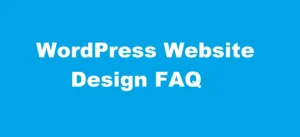
In the world of digital presence, a well-designed website can be a game-changer. WordPress, a versatile content management system, has become a preferred choice for businesses and individuals looking to create impactful websites. At WebAllWays, we understand the significance of a meticulously crafted WordPress site. This comprehensive FAQ guide aims to answer the most common questions about WordPress website design, providing insights into best practices, key considerations, and essential tips for creating an effective and visually appealing site.
What is WordPress Website Design?
WordPress website design refers to the process of creating and customizing a website using the WordPress platform. Unlike development, which focuses on coding and technical functionalities, design is concerned with the visual aspects of the website. This includes layout, color schemes, typography, imagery, and overall aesthetics. Good design enhances user experience, reinforces brand identity, and improves engagement and conversion rates.
Why Choose WordPress for Website Design?
User-Friendly Interface
WordPress is renowned for its user-friendly interface, which allows designers to build and manage websites efficiently without requiring extensive coding knowledge. Its intuitive dashboard and visual editors simplify the design process, making it accessible even for those with limited technical expertise.
Flexibility and Customization
Flexibility is one of the major advantages of using WordPress. With thousands of themes and plugins available, designers can easily customize the appearance and functionality of a website. Whether you need a simple blog or a complex e-commerce site, WordPress can be tailored to meet diverse design needs.
SEO-Friendly Features
WordPress is built with search engine optimization (SEO) in mind that’s why it offers various features and plugins that can enhance your site’s visibility on search engines. A well-designed WordPress site can significantly improve your search rankings and drive more organic traffic to your site.
Responsive Design Capabilities
In today’s mobile-centric world, it is essential to have a responsive website. WordPress themes are often designed to be mobile-friendly, ensuring that your website looks and functions well on all devices. Responsive design improves user experience and your SEO performance.
How to Design WordPress Website?
To design a WordPress website, choose a theme that suits your needs (free or premium), customize it using the WordPress Customizer or a page builder like Elementor, and add necessary plugins for additional functionality. Focus on creating a clean layout, easy navigation, and mobile responsiveness.
What Are the Key Elements of a Good WordPress Website Design?
Layout and Structure
Your website layout determines how content is presented and organized. A well-structured layout guides visitors through your site, making it easy for them to find information. Consider the following aspects:
- Header and Navigation: Ensure that your navigation menu is clear and accessible, providing easy paths to key pages.
- Content Sections: Divide content into digestible sections with appropriate headings and subheadings.
- Footer: Include important links and information in the footer for easy access.
Visual Design and Branding
Visual design plays a significant role in creating a memorable and engaging user experience. Key elements include:
- Color Scheme: Choose a color palette that aligns with your brand identity and creates a cohesive look across the site.
- Typography: Select the right fonts that reflect your brand’s personality or at least legible. Consistent use of typography enhances readability and aesthetic appeal.
- Images and Graphics: Use high-quality images and graphics that complement your content and enhance visual interest.
User Experience (UX) Design
A positive user experience is essential for retaining visitors and encouraging engagement. Consider the following UX principles:
- Ease of Navigation: Design intuitive navigation that allows users to find information quickly.
- Loading Speed: Optimize images and use efficient coding practices to ensure fast page load times.
- Accessibility: Make sure your website is accessible to every user, including those with disabilities. This involves using alt text for images, ensuring color contrast, and providing keyboard navigation options.
Mobile Optimization
With the increasing use of mobile devices, it is very important to have your WordPress site mobile-friendly. Responsive design ensures that your site adapts to different screen sizes, providing a seamless experience on smartphones and tablets.
How to Choose the Correct WordPress Theme for My Website?
Define Your Needs and Goals
Before selecting a theme, outline your website’s objectives and requirements. Consider the following:
- Purpose of the Website: Whether it’s a blog, portfolio, e-commerce site, or business website, choose a theme that aligns with your purpose.
- Features and Functionality: Identify any specific features you need, such as a contact form, gallery, or online store.
Evaluate Theme Quality
Not all themes are created equal. Look for themes that are:
- Well-Coded: Ensure the theme is built with clean and efficient code to avoid performance issues.
- Regularly Updated: Choose a theme that is updated regularly to ensure compatibility with the latest WordPress version and plugins.
- Responsive and Cross-Browser Compatible: Verify that the theme looks and functions well across different devices and browsers.
Customizability and Support
Consider the customization level available with the theme you’re going to choose. A good theme should offer options to adjust colors, fonts, and layouts without requiring extensive coding. Additionally, check if the theme includes support and documentation to assist you with setup and customization.
What are some of the best free WordPress themes?
Some of the best free WordPress themes include Astra, OceanWP, Neve, GeneratePress, and Hello Elementor. These themes are highly customizable, lightweight, and optimized for speed and SEO. They also offer compatibility with popular page builders like Elementor and Gutenberg. For specific needs, themes like Hestia or Zakra are also great options.
What Are WordPress Plugins and How Do They Affect Design?
Understanding WordPress Plugins
Plugins are tools that provide specific functionality to your WordPress site. They can add features, enhance design elements, and improve user experience. Some plugins are specifically designed for design purposes, such as page builders and customizer tools. There are some plugins
Essential Design Plugins
Consider incorporating the following design-related plugins:
- Page Builders: Plugins like Elementor and WPBakery allow for drag-and-drop design, enabling you to create complex layouts without coding.
- SEO Plugins: Tools such as Yoast SEO or All in One SEO can help optimize your content and improve search engine visibility.
- Image Optimization Plugins: Plugins like Smush can compress and optimize images to enhance site performance and loading times.
How Do I Ensure My WordPress Website Design is SEO-Friendly?
Optimize Page Speed
Page speed is a crucial factor in SEO and user experience. Optimize your website design by:
- Compressing Images: Use tools to reduce image file sizes without compromising quality.
- Minifying CSS and JavaScript: Remove unnecessary code and reduce file sizes to improve load times.
- Using Caching Plugins: Implement caching to store static versions of your site and reduce server load.
Implement On-Page SEO Best Practices
Design your website with SEO in mind by:
- Creating SEO-Friendly URLs: Use descriptive and keyword-rich URLs for your pages and posts.
- Optimizing Meta Tags: Include relevant keywords in meta titles and descriptions to improve search visibility.
- Adding Alt Text to Images: Use descriptive alt text for images to enhance accessibility and search engine indexing.
Ensure Mobile-Friendliness
Google’s mobile-first indexing prioritizes mobile versions of websites in search rankings. Make sure your design is responsive and provides a best experience on all devices.
What Are Common Design Mistakes to Avoid?
Overloading with Information
Avoid cluttering your website with too much information. Focus on clear and concise content presentation to maintain user engagement and prevent overwhelm.
Neglecting Mobile Optimization
With the majority of users accessing websites via mobile devices, neglecting mobile optimization can lead to a poor user experience and lower search rankings.
Using Inconsistent Branding
Maintain consistency in branding elements such as colors, fonts, and imagery to reinforce your brand identity and create a cohesive user experience.
Ignoring User Feedback
To identify areas for improvement, pay attention to user feedback and analytics. Regularly review and update your design based on user behavior and preferences.
How Do I Build a Directory in WordPress?
To build a directory in WordPress, use the Best Free WordPress Directory Plugins like Business Directory Plugin, GeoDirectory, or Directorist. Install your chosen plugin, configure settings, create categories, and add listings. These plugins provide easy-to-use tools for managing and displaying directory content.
How do you create a contact form in WordPress?
To create a contact form, you can either use a plugin or manually code it.
- Using a Plugin: Install WordPress Contact Form Plugins like Contact Form 7 or WPForms, which allows you to easily create and manage forms without any coding.
- Without a Plugin: You can create a simple HTML form and use PHP to handle form submissions, sending the data to your email.
How to Create a Sticky Header in WordPress?
To create a sticky header in WordPress, you can either use a theme that supports this feature or add custom CSS/JavaScript. Plugins like myStickymenu or Sticky Menu (or Anything!) on Scroll can easily add this functionality without coding. Alternatively, you can modify your theme’s CSS to make the header “stick” to the top of the page when users scroll.
How to Stop WordPress User Registration Spam?
To prevent spam registrations in WordPress, you can use plugins like Akismet or reSmush.it, which help block suspicious or bot-generated accounts. Additionally, enabling CAPTCHA on the registration form or using tools like Wordfence or WPBruiser can reduce spam sign-ups. You can also manually disable the “Anyone can register” setting or restrict user roles.
How Can WebAllWays Help with Your WordPress Website Design?
Expert Design Services
At WebAllWays, our team of experienced designers specializes in creating visually stunning and highly functional WordPress websites. We work closely with clients to understand their needs and deliver customized design solutions that align with their goals.
Comprehensive Support
We provide end-to-end support, from theme selection and customization to ongoing maintenance and updates. Our goal is to ensure your website remains current, secure, and optimized for performance.
SEO Integration
Our design process incorporates SEO best practices to enhance your site’s visibility and drive organic traffic. We focus on creating a design that not only looks great but also performs well in search engine rankings.
Responsive and Mobile-Friendly Design
We prioritize responsive design to ensure your website delivers a seamless experience across all devices. Our designs are optimized for mobile users, enhancing accessibility and user satisfaction.
Conclusion
Designing a WordPress website involves much more than just choosing a theme and adding content. It requires careful consideration of layout, visual elements, user experience, and SEO. By following best practices and avoiding common pitfalls, you can learn to design a WordPress website that is both aesthetically pleasing and highly functional.
At WebAllWays, we are committed to delivering exceptional WordPress website design services that meet your unique needs and goals. If you have any questions or need assistance with your WordPress site, feel free to reach out to our team. We are here to help you build a website that stands out and drives success.
